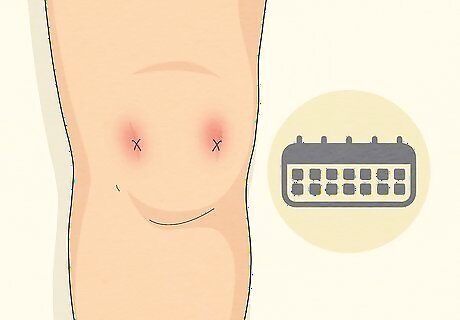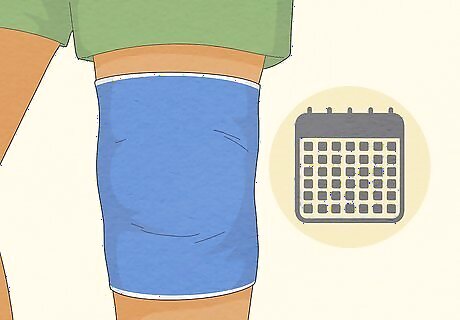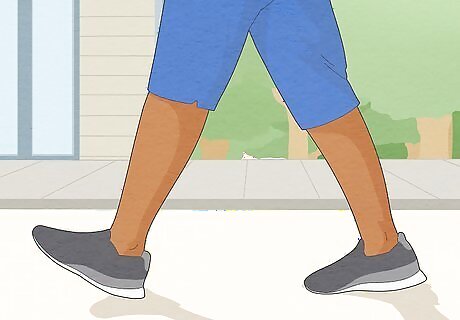
views
X
Research source
Don’t try to grin and bear this injury on your own; instead, visit a doctor first to get a thorough diagnosis of your injury. Don’t worry. We’re here to help walk you through all your treatment options, so you can get back on your feet as soon as possible.
Can a meniscus tear heal on its own?

Yes, but it depends on how bad the tear is. Small tears along the outer third of your meniscus can heal independently, and might not need surgery. However, tears along the inner two-thirds of your meniscus will probably need surgery. Don’t worry; at your appointment, a doctor can pinpoint your injury and point you in the right direction for treatment. A lot of meniscus tears can heal without surgery.
What at-home remedies can I try?

Follow the RICE method. “RICE” is an acronym for Rest, Ice, Compression, and Elevation, which are the four main things you need to recover safely and comfortably at home. After your injury, the RICE method helps reduce any swelling and discomfort while encouraging flexibility and recovery in the process. Here’s what you have to do: Rest: Avoid the sport or activity that caused your tear in the first place, and use crutches as needed to get around. Ice: Wrap a cold pack in a towel or rag and ice your injured knee for 20 minutes at a time, multiple times throughout the day. For your own safety, never ice your knee directly. Compression: Wrap an elastic compression bandage around your injured knee. Keep the bandage snug, but not too tight—if your knee feels tingly or numb, rewrap the bandage a bit looser. Elevation: When you can, prop your injured leg up so it’s above your heart.

Take painkillers if your injury isn’t severe. If your torn meniscus doesn’t cause your knee to lock in place, you can take over-the-counter painkillers, like ibuprofen or acetaminophen, to address the swelling and pain. Check-in with your doctor if your knee still hurts after 6 weeks; at this point, surgery is your next best option. Acetaminophen: Adults can take 1 regular-strength acetaminophen pill every 4-6 hours. If 1 pill doesn’t help, try 2 pills next. For your own safety, limit yourself to 12 pills or less each day. Ibuprofen: For MOTRIN, take 1-2 pills once every 4-6 hours. With Advil, take 1 pill per every 4 hours or 2 pills per every 6-8 hours. For either medicine, limit yourself to 6 pills per day. Naproxen sodium: Take a single pill every 8-12 hours. As a safety precaution, limit yourself to 2 pills each day. Aspirin: Take 1-2 pills every 4-6 hours. Cap yourself off at 12 pills each day so you don’t overdose.
What other non-surgical treatments are there?

Talk to your doctor about steroid injections. Corticosteroids may help with the pain, and can help lower swelling. At your appointment, your doctor will inject the steroids directly into your joint, which may get rid of some pain and swelling. Researchers are also developing a plasma injection that may help heal meniscus tears.

Visit a physical therapist. Physical therapy is helpful for any kind of meniscus tear, even if you don’t need surgery. A physical therapist might provide manual therapy, suggest icing and compression treatments, use neuromuscular electrical stimulation (NMES), and suggest different exercises to help you recover. Eventually, your therapist will help you figure out when you can go back to an active routine.
Do I need surgery?

Possibly, if the tear is really severe. During the procedure, your surgeon will slide a tiny camera into your knee so they can clearly see the injury. Depending on the tear, they’ll either fix or remove the meniscus tear using tiny surgical tools. Afterward, your surgeon might suggest physical therapy to help support your knee and get you back in shape for your favorite sports and usual activities. Typically, your surgeon will either perform a meniscus repair, where the meniscus is sewn back together, or a partial meniscectomy, where damaged meniscus tissue is removed. Unfortunately, most meniscus tears can’t be repaired, so partial meniscectomies are more common. Meniscus surgery is safe and doesn’t have many complications. In fact, over 98% of surgeries don’t end up having any kind of complications whatsoever.
How long does it take to recover from torn meniscus surgery?

You can go back to normal activities within a few weeks. You’ll feel worn out for a few days after your surgery and your knee might feel numb for several days, due to the incisions your surgeon made. Your recovery time ultimately depends on the type of surgery you received, as meniscus repair surgery takes longer to heal than a meniscectomy. After a meniscectomy, you can apply weight to your knee right away; walk without the help of crutches within 2-7 days; drive a car within 1-2 weeks; get full range of motion between 1-2 weeks; and play sports after 4-6 weeks. After meniscus repair surgery, you can put weight on your knee while wearing a brace; move without crutches within 4-6 weeks; drive a car between 4-6 weeks; get full range of motion after at least 4-6 weeks; and play sports after 3-6 months.
How long does it take for a torn meniscus to heal without surgery?

It should heal within 6 weeks. At this point, your knee shouldn’t look swollen or feel painful anymore. Unfortunately, if it still hurts at this point, your injury likely won’t heal without surgery. Serious meniscus tears might not heal independently. Always visit a doctor first so you can understand the full scope of your injury.
What is the prognosis for a torn meniscus?

Most people can go back to their usual activities with the help of physical therapy. During rehab, your physical therapist may walk you through at-home treatments, and help you safely adjust to everyday activities, like walking and climbing stairs. While every case is different, many people can go back to their usual routines after 4 months of regular physical therapy. With a few months of rehab, you can do everything that you used to do before the injury.
How do I know if I have a torn meniscus?

You can’t move your knee as much. After a meniscus tear, you might not be able to straighten or rotate your knee like you normally would. You might also feel like your knee is locked, or that it can’t support your weight.

Your knee is really sore. Pay attention to your regular, daily movements, like climbing out of bed or walking down the street. With a meniscus tear, your knee might feel painful, swollen, and/or extra stiff. You might also feel like your knee is popping. The pain may be especially obvious when you rotate or twist your knee.
Do I need to see a doctor?

Yes, you should see an orthopedic physician. A physician can check out your knee and tell you how bad the tear is. Depending on how bad the injury is, your doctor might recommend at-home treatments, or suggest getting surgery to fix the tear. During your appointment, your doctor might see how much you can move your knee, and see if your knee feels sore or tender. They might also do an MRI or X-ray to get a better idea of where the tear is.
Can you walk around on a torn meniscus?

Yes, but you should still see a doctor. A torn meniscus may seem easy to ignore at first, but it can lead to bigger problems later on. An untreated injury can lead to arthritis and other serious knee issues if not treated.




















Comments
0 comment